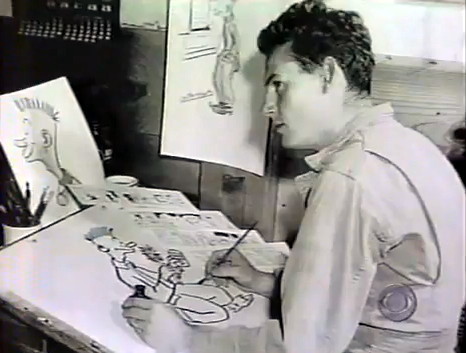Thiebaud at Walt Disney Studios
Thiebaud went to junior college in the 1940s, but his art
studies were interrupted by World War II.
He served in the Army as an artist and cartoonist, fortunately keeping
him out of combat. Afterwards, he
married and moved to Los Angeles where he worked as a commercial artist and
illustrator. At the age of 29, he went
back to college, at California State University, to receive degrees in art, art
history, and education. In order to
support his family, Thiebaud decided to teach art to college students while
simultaneously pursing a career as a serious painter.
"Pies, Pies, Pies" (1961), by Wayne Thiebaud
"Cakes and Pies" (1995) by Wayne Thiebaud
His focus on consumer goods placed him under the Pop Art
label that was also emerging around this time.
In New York, his paintings were shown alongside the work of Andy Warhol,
Roy Lichtenstein, and James Rosenquist.
However, Thiebaud didn’t associate with these artists and preferred to
describe himself as a traditional painter. He once said, "Painting is more important than art. Art--art we don't know what the hell it is--though we think we do, or try to do. Whenever one of my students says he's off to do his art, I say, Not so fast," (Gopnik, 40).
I recently noticed Thiebaud’s work in an English seminar at
UNC that focuses on food and culture; his paintings have been featured on
nearly every New Yorker Food issue,
and I was immediately drawn to their unique colors and texture. I went on to read more about his inspiration
and understanding of art as a profession. A fantastic article on Thiebaud by Adam
Gopnik, entitled “An American Painter,” writes, “he seems to have been stirred
by a lower, more commonplace lingua franca of American display…the soda
fountain, the cosmetic counter, the hardware store—that entire world in which
things seem to have been over-ordered, given more display value than the
demands of buying and selling strictly demanded, “fetishized” beyond the
intrinsic need to allure people in to buy glasses or bow ties or hammers and
nails,” (Gopnik, 46). He depicts these
displays with thick paint that adds decadence to every canvas he touches. As a result, the audience feels as though
they are looking through glass at an abundance of cookie cutter consumer goods. The intense shadows elicit the sentiment of nostalgic
afternoon sunlight. To this day, I feel
that Thiebaud’s work is both unique and sensational.
SOURCES:
National Gallery of Art, Washington, DC. 2013. http://www.nga.gov/education/classroom/counting_on_art/bio_thiebaud.shtm
American Academy of Achievement, 2011.
Gopnik, Adam. "An
American Painter" in Steven A. Nash with Adam Gopnik, Wayne Thiebaud, A Paintings Retrospective (New York: Thames & Hudson, 2000), pp.39-67




No comments:
Post a Comment